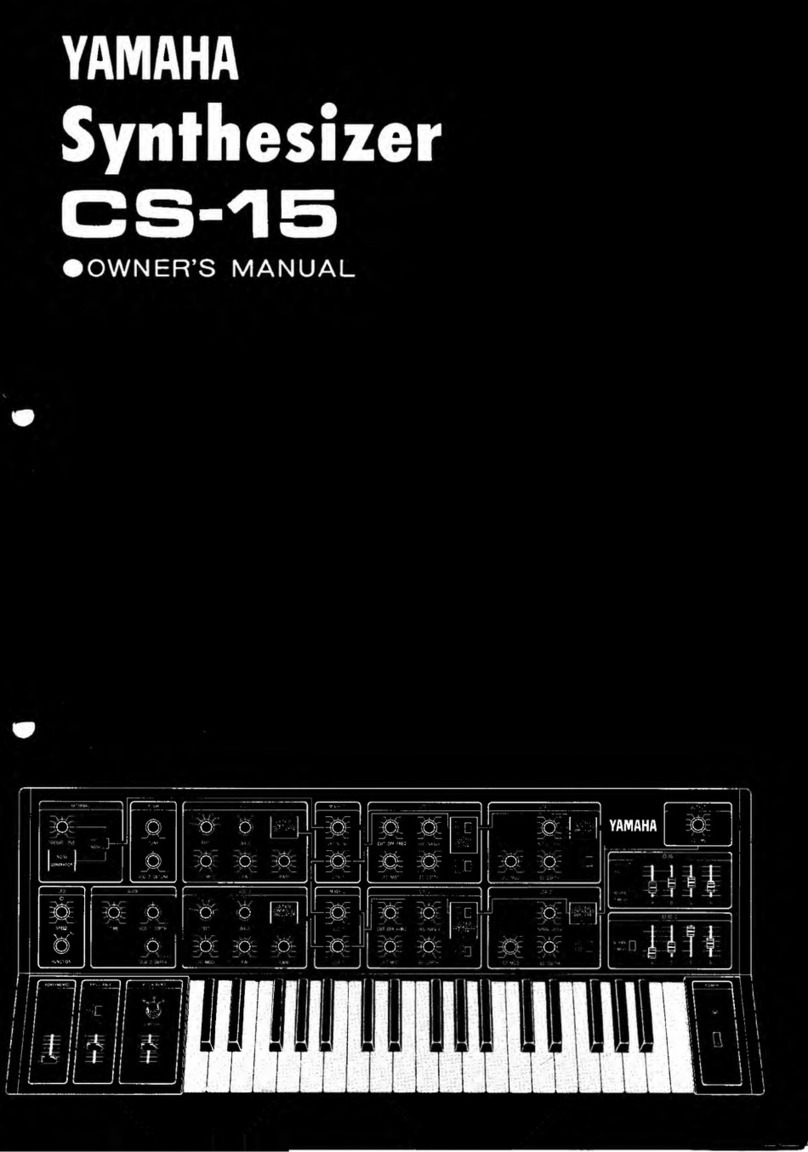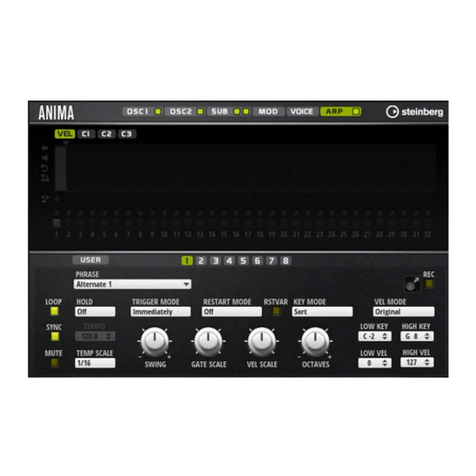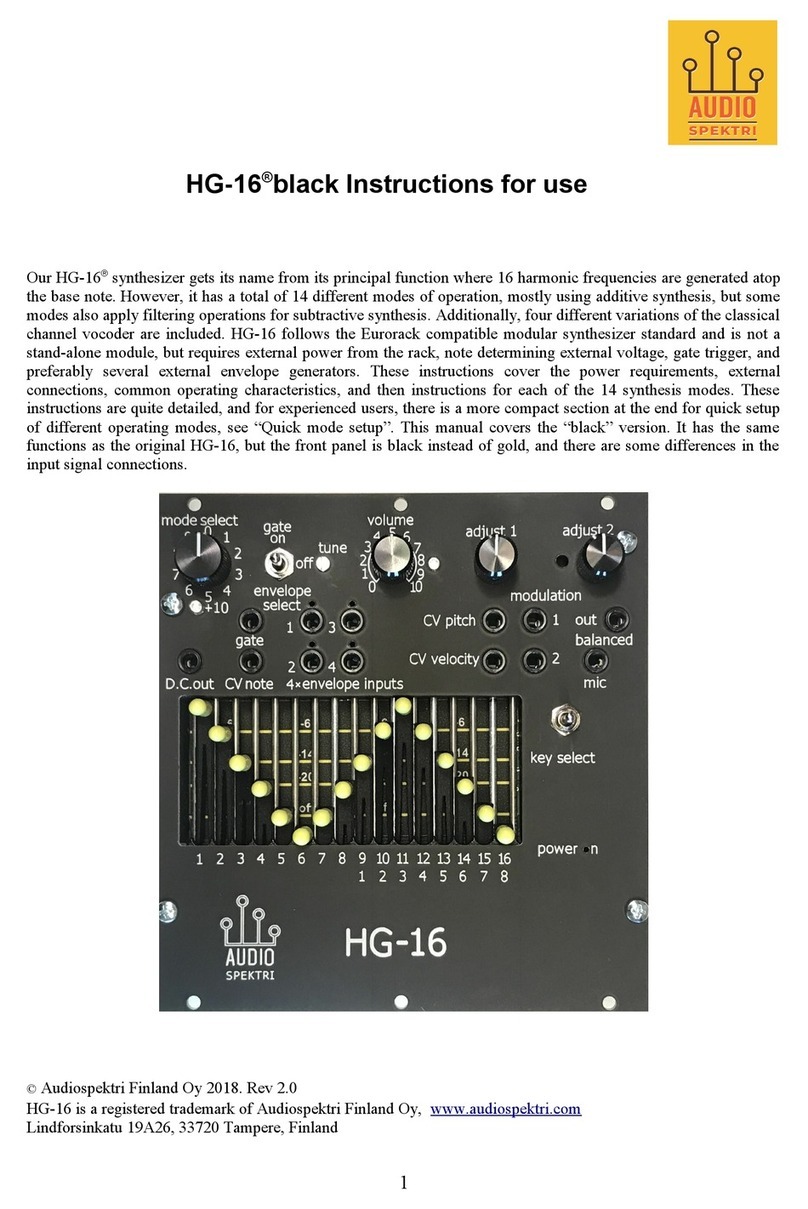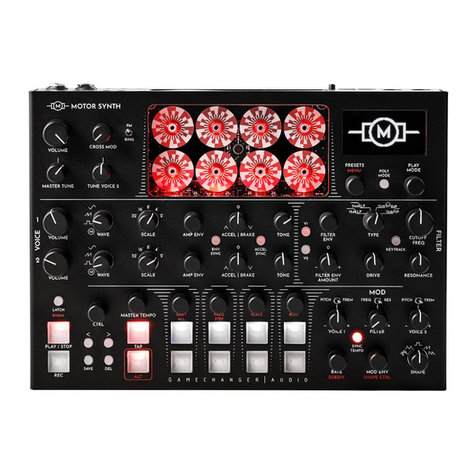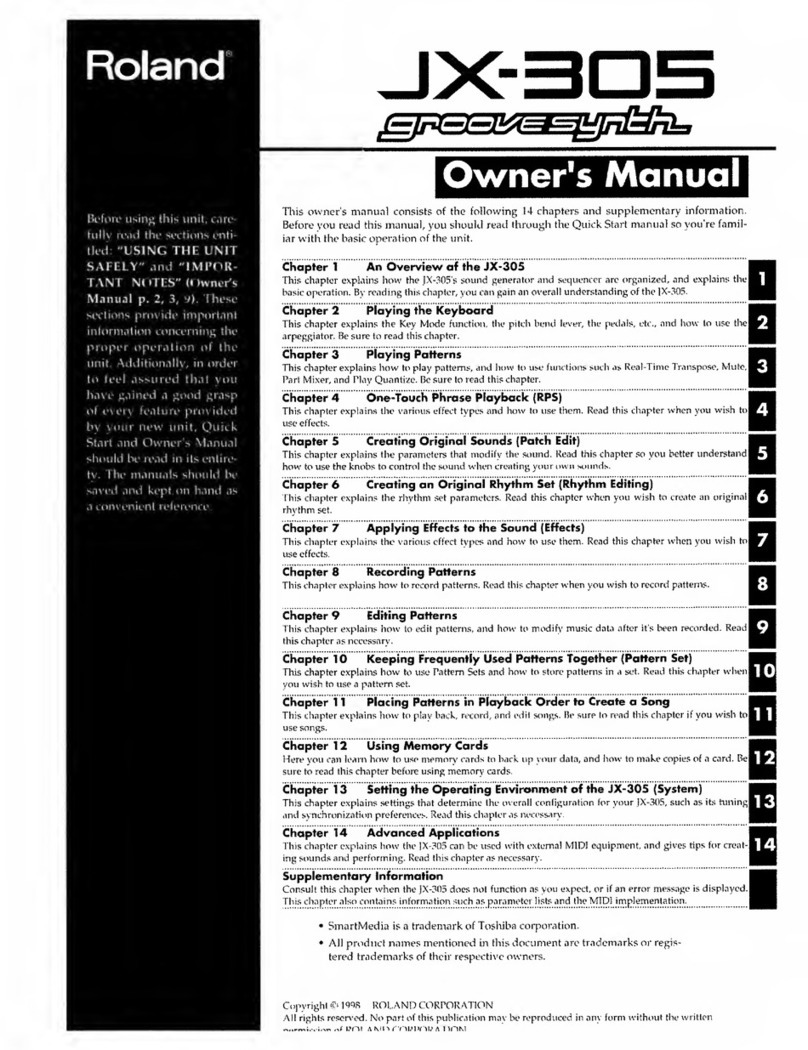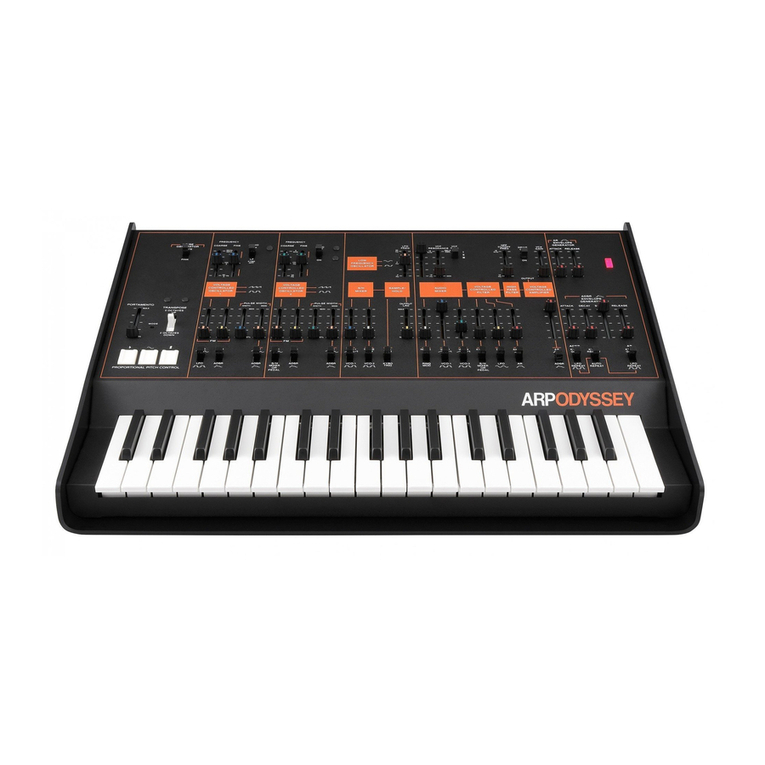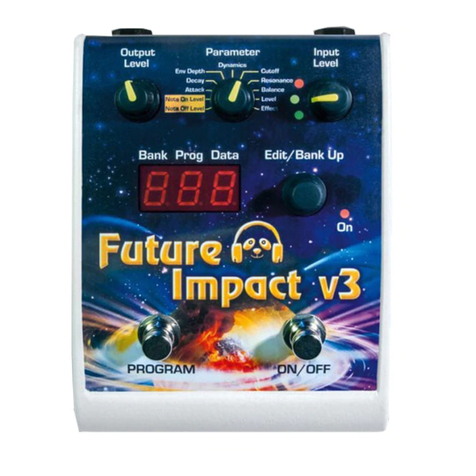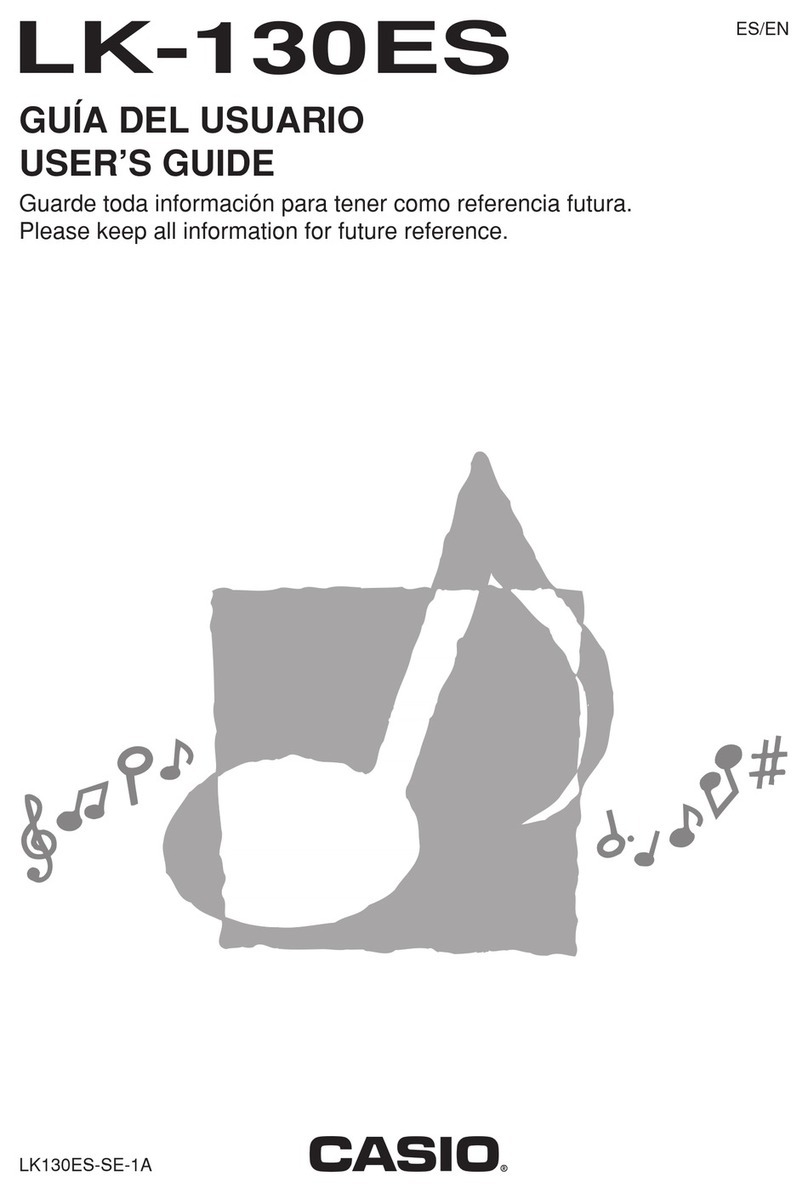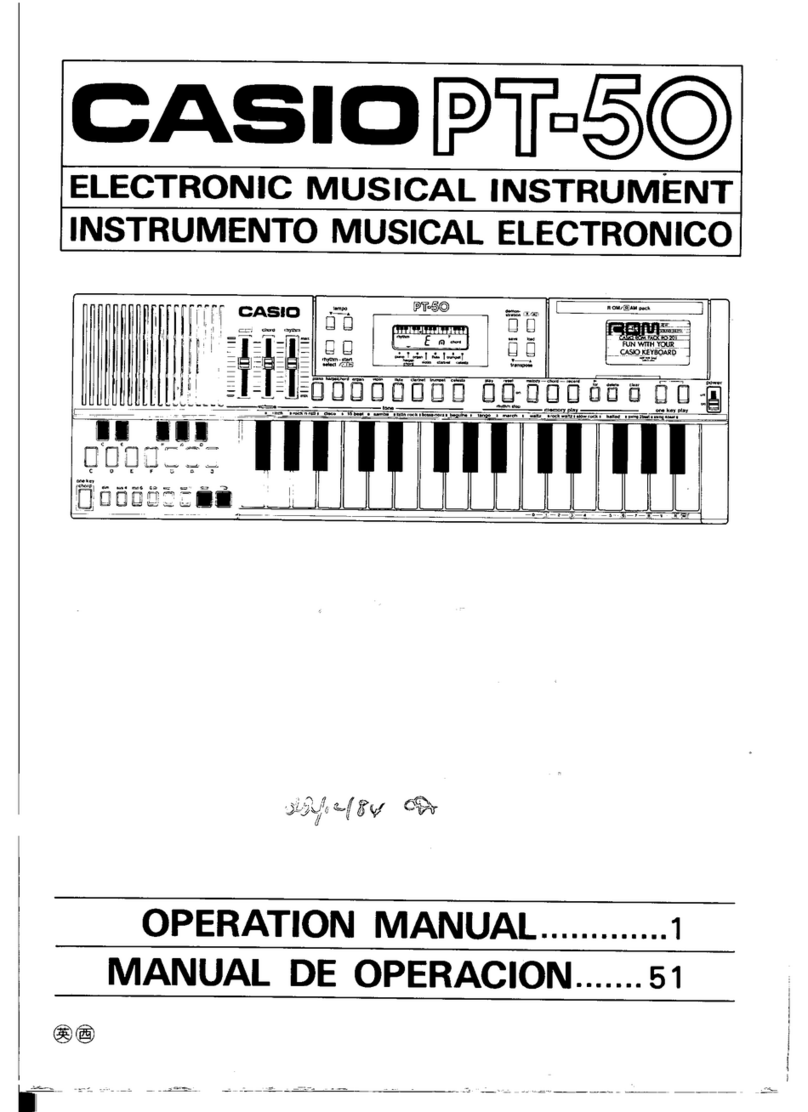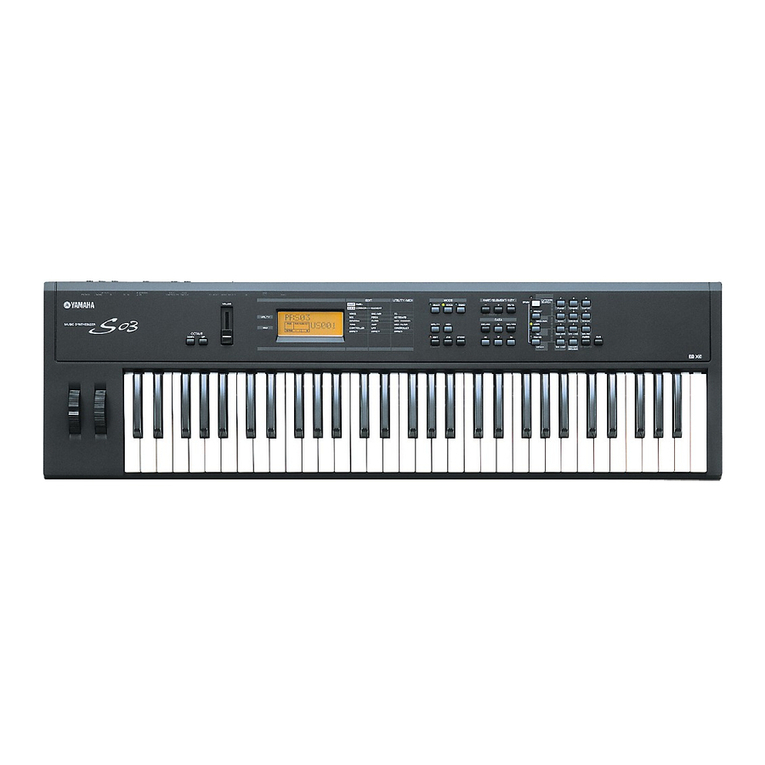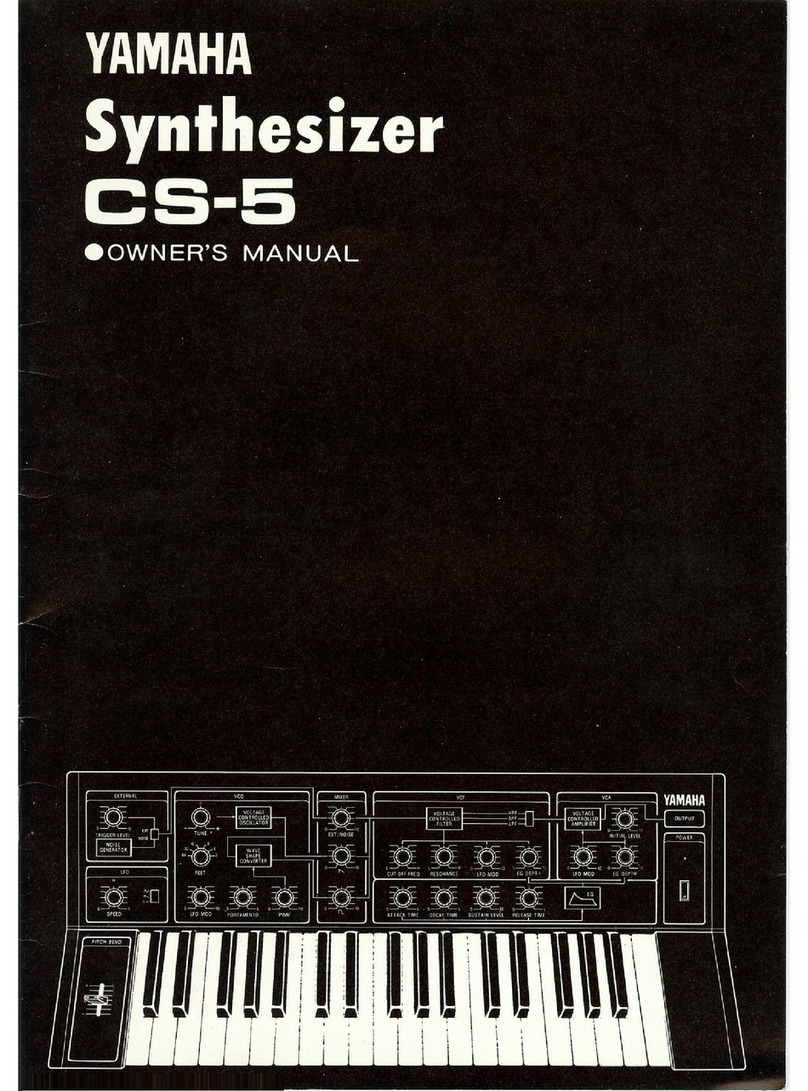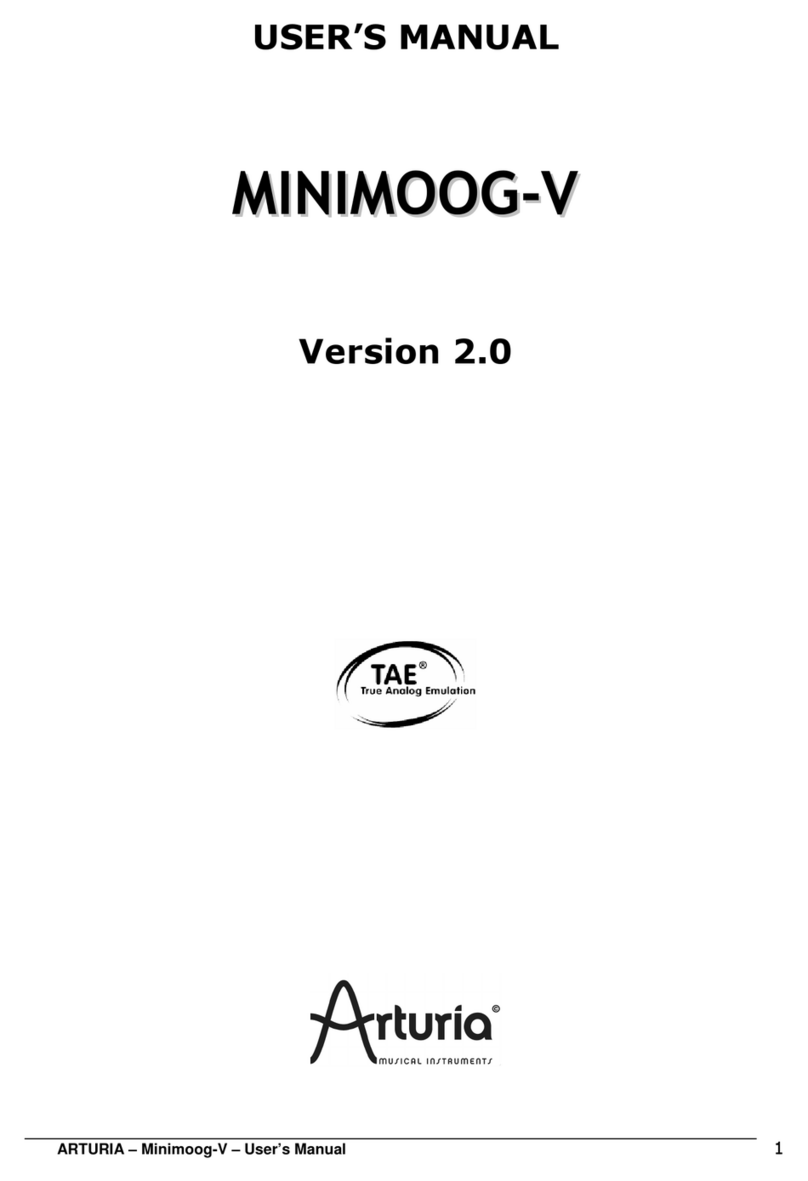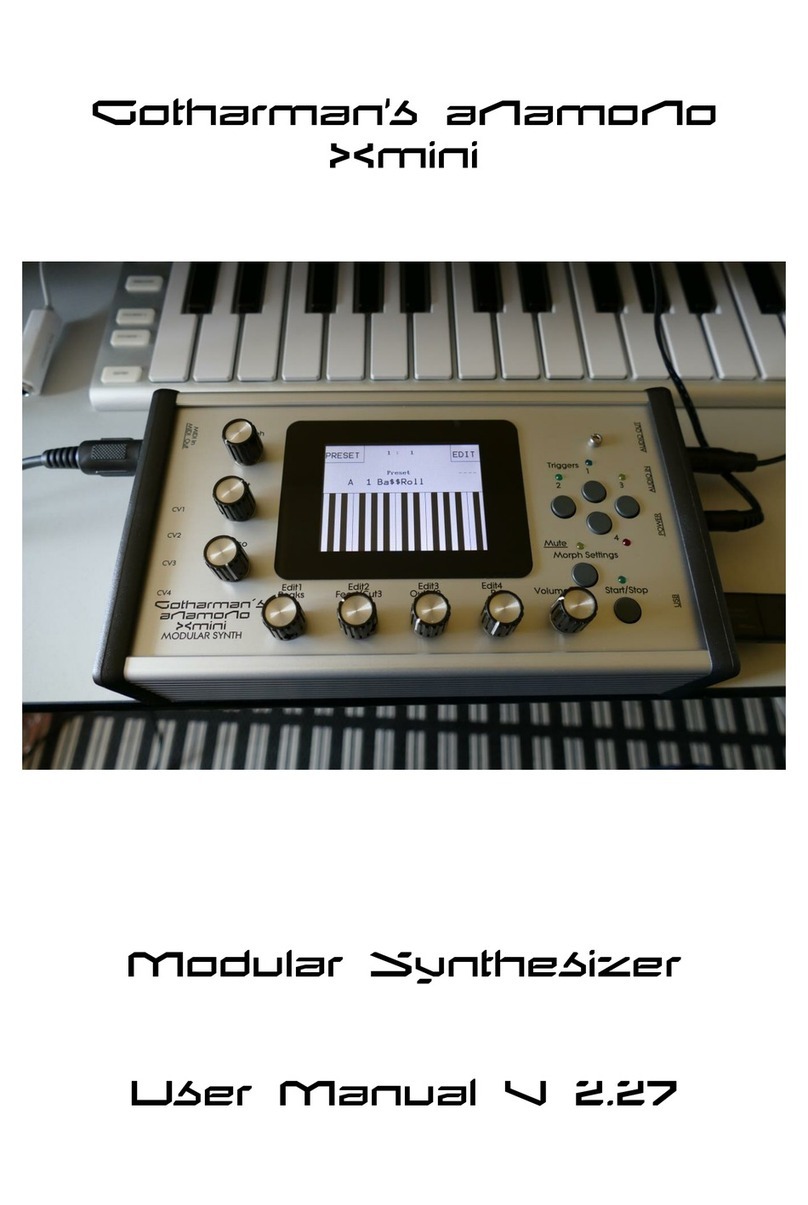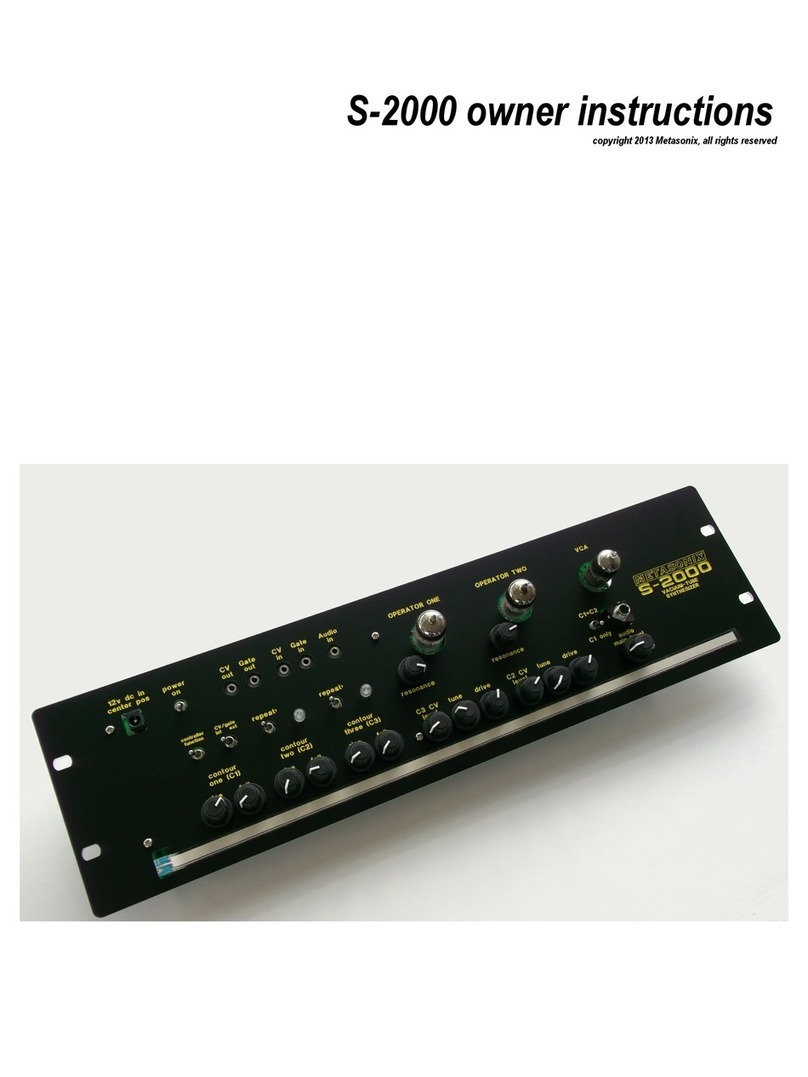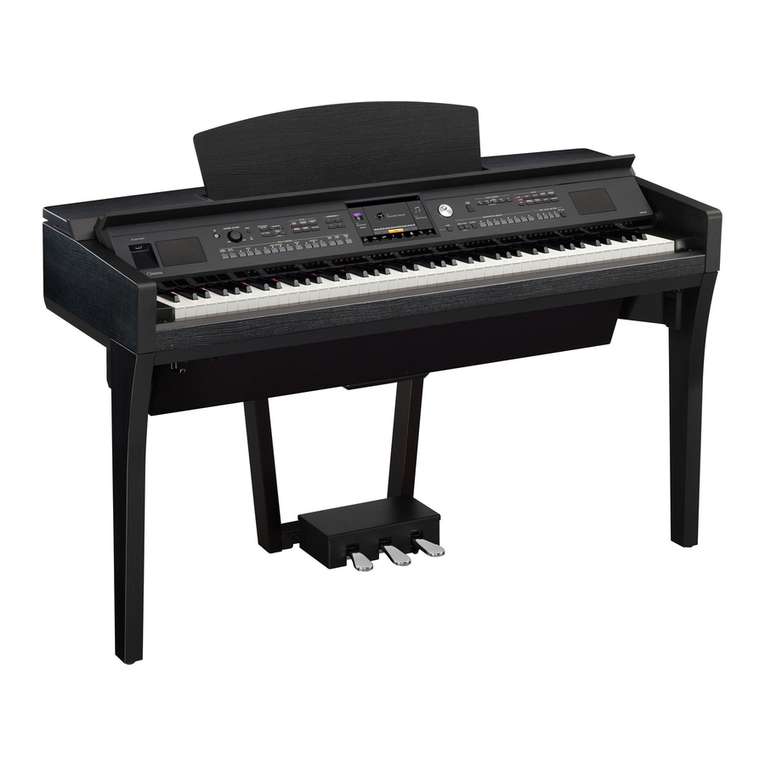MANIKK ADSR User manual

MANIKK ADSR
Advanced Envelope Generator - Eurorack Module
Users Guide

MANIKK ADSR
Users Guide
Document version 1.03
ã 2019 manikk
SWEDEN

Table of Contents
Front panel layout ...................................................................... 1
Welcome .................................................................................... 2
Overview .................................................................................... 3
User interface and navigation .................................................... 4
Feature-buttons .......................................................................... 4
MOD-button ............................................................................... 4
MOD-mode ...................................................................................... 4
Config-mode .................................................................................... 4
LED’s ......................................................................................... 5
Normal run mode ............................................................................. 5
MOD mode ...................................................................................... 5
Config mode .................................................................................... 5
Parameters on the front-panel ................................................... 6
LOOP ......................................................................................... 6
INV ............................................................................................. 6
JUMP ......................................................................................... 6
FRZ ............................................................................................ 6
REV ............................................................................................ 7
AMPL ......................................................................................... 7
RANG ......................................................................................... 7
MOD ........................................................................................... 7
MOD-mode ...................................................................................... 7
Config-mode .................................................................................... 7
Config parameters ..................................................................... 9
Alternative modulation style ....................................................... 9
On/off-parameters ............................................................................ 9
Value-parameters ............................................................................ 9
Retrig-type ............................................................................... 10
Gate-type ................................................................................. 10
Sustain-mode ........................................................................... 10
Amplitude-mode ....................................................................... 10

Range-mode ............................................................................ 11
MIDI-mode ............................................................................... 11
1 – MIDI off .................................................................................... 11
2 – 31.250 (MIDI) ........................................................................... 11
3 – 115.200 .................................................................................... 11
4 – 230.400 .................................................................................... 11
Learn-mode ................................................................................... 12
Factory reset ............................................................................ 12
Connections ............................................................................. 13
Power connector ...................................................................... 13
Modulation input jack ............................................................... 13
Retrig input jack ....................................................................... 13
Gate input jack ......................................................................... 13
EG output jack ......................................................................... 13
Otto Active Expander pins ....................................................... 14
Pins on the back of the ADSR module .......................................... 14
Active Expander output jacks ........................................................ 16
MIDI pins .................................................................................. 17
MIDI Implementation ................................................................ 18
Technical details ...................................................................... 20
More information ...................................................................... 20
Warranty .................................................................................. 20

MANIKK ADSR
1
Front panel layout

2
Welcome
Congratulations to your purchase of this module.
The manikk ADSR is an advanced envelope generator, capable of producing normal
ADSR-envelopes but also a number of experimental envelopes. In loop-mode, it can
also be used as LFO.
It is a linear envelope generator with modulation capability.
The module can also be used as a gate delay by using the “Jump”-parameter.
As usual, you need to install it properly inside a case made for Eurorack synthesizer
module systems.
The module can be expanded with a manikk Otto Active Expander. The expander
gives eight additional digital outputs for different states of the module.
All parameters can also be controlled by MIDI-CC with an optional midi module.
Happy tweaking!

3
Overview
Manikk ADSR is a linear envelope generator.
You can use it to create normal linear ADSR-style envelopes, but you can also use
the parameters and modulation capabilities to create other type of envelopes.
In loop-mode the module can be used as LFO. By using the jump-parameter, the
module can be used as a gate delay.
Main features:
• Linear behavior
• Loop – after a completed envelope it starts over again and again…
• Invert – the envelope is inverted and moves from max to zero and back to
max again.
• Jump – no gliding between the phases, it just waits and jumps to the target
level.
• Freeze – freeze the time and hold the current envelope output level.
• Reverse – run backwards: R-S-D-A.
• Amplitude – lower or modulate the amplitude.
• Time-range – extend or modulate the A, D, R-times.
• Modulation – the modulation jack can modulate most of the parameters.
• Retrig input jack – retrig an ongoing envelope.
• Gate/trig input jack – start the envelope.
• EG output jack – the resulting output curve (0 – 8,2V) .
Almost all of the parameters can be modulated by the modulation input jack.
Some basic behaviors can be configured by a number of config-parameters.

4
User interface and navigation
Feature-buttons
All buttons except for MOD controls different features directly.
When you make a short press on those buttons, you turn that feature on or off.
A red led indicates if the feature is on.
MOD-button
The MOD-button is special.
MOD-mode
If you make a short press, the module will go into MOD-mode. In MOD-mode the
MOD and the MODULATION jack leds are lit. The 7 feature leds now indicates if
that feature is affected by the modulation jack or not.
To return to run-mode from MOD-mode, you just make a short press again on the
MOD-button. The MOD led will turn off.
Config-mode
If you long-press (hold the MOD-button for a longer time), the module will go to
config-mode. Config-mode is indicated by a blinking MOD-led. An additional led
will also blink that indicates which config-parameter you are editing.
If you make a short press on the MOD-button when you are in config-mode, you will
cycle to the next config-parameter.
If you want to change the config-parameter, you use the Loop-button to cycle the
values for that config-parameter.
To leave config-mode and return to run-mode, you need to make a long-press again
on the MOD-button. The blinking leds will turn off and the MOD-led will also turn
off.
See the chapter “Config-parameters” for more information about each parameter and
their values.

5
LED’s
The module can be in three different modes described here:
Normal run mode
The leds indicates the status of the 7 features. Use the buttons to turn on or off.
MOD-led is turned off.
Modulation led shows if the modulation input signal peaks. The modulation range is
-5V to +5V.
Retrig and Gate leds indicates if these jacks have logic high input signals.
EG out led indicates if there is an envelope ongoing.
The leds under the A,D,S,R potentiometers indicates which phase the envelope
currently is in.
MOD mode
The MOD-led is lit.
The 7 feature leds shows if that feature is controlled by the modulation input jack.
Use the buttons to turn modulation on or off for the features. Long press on the 4 left
buttons toggles the A, D, S, R features on/off. In total the modulation input jack can
control 11 parameters.
Config mode
The MOD led is blinking.
Additional leds will also blink to indicate which config-parameter you are editing.
See the chapter “Config-parameters” for more information.

6
Parameters on the front-panel
LOOP
Puts the envelope generator in looping mode. As long as the gate is high, it will create
a looping ADSR curve. In loop-mode the module acts like a LFO.
There is a config-parameter that where you can select the sustain-mode. The sustain-
mode controls how the sustain state should behave. Normal sustain or the same fixed
time as the A, D or R phases. For more information see the config-parameters chapter.
Modulating this parameter turns the feature on or off.
INV
Inverts the envelope.
Normally the envelope starts from zero and reaches its maximum at the end of the
Attack phase, then reaches the sustain level within the Decay time. When the gate is
released the output goes from sustain level back to zero.
When it is inverted, it starts at the maximum level and goes to zero and then back to
max again.
Modulating this parameter turns the feature on or off.
JUMP
When jump is turned on, the curve will not glide to the next level. It will instead jump
and therefore make square-wave-like outputs. This can also be used as gate delay.
Modulating this parameter turns the feature on or off.
FRZ
When you activate the freeze, the current level of the output curve will freeze and
hold at that current level. It will stay at that level as long as the freeze is turned on.
When freeze is turned off again, the curve will continue from that level. You can
think of this as if you “stop the time”.

7
Modulating this parameter turns the feature on or off.
REV
Reverse the order of the phases and run “backwards”.
Normally the order of the phases is ADSR. When reversed, the order is RSDA.
In reverse mode, it starts with Release and goes to Sustain, stays at the sustain until
the gate goes low, then it finishes with a Decay and finally Attack back to zero.
Modulating this parameter turns the feature on or off.
AMPL
When you turn AMPL on, the amplitude of the output will be half the normal output
level.
Modulating this parameter increases or decreases the value for this parameter.
RANG
This feature slows down the envelope. All the time-settings (A, D, R) will be
multiplied by a slowdown-factor.
Modulating this parameter increases or decreases the value for this parameter.
MOD
MOD-mode
Short press on the MOD-button goes from run-mode to MOD-mode.
In MOD-mode you use the other 7 buttons to select which parameters you want to be
controlled by the modulation input jack.
Long press on the 4 left buttons toggles the A, D, S, R-modulations on or off.
Short-press again on the MOD-button exits MOD-mode and returns to run-mode.
Config-mode
Long press on the MOD-button goes from run-mode to config-mode.

8
In config-mode you use the MOD-button to cycle to the next config parameter and
you use the LOOP-button to cycle the values for the currently selected config-
parameter.
The value for the currently selected config-parameter is indicated by the four A, D,
S, R-leds. You can think of this as values 1, 2, 3 or 4.
The MOD-led is blinking and additional leds are also blinking to indicate which
parameter you are editing.
Long press again on the MOD-button will exit config-mode and go back to run-mode.
See the chapter “Config-parameters” for more information.

9
Config parameters
See the chapter “User interface and navigation” how to enter config-mode.
Use short press on MOD-button to step to the next config-parameter.
Use short press on LOOP-button to change the value for the currently selected
parameter.
The config parameters are cycled in the following order:
Alternative modulation style
MOD and MODULATION leds are blinking.
Press the 7 feature buttons to turn on or off the alternative modulation style for that
feature. Long press on the 4 left buttons toggles the A, D, S, R features on /off.
On/off-parameters
The on/off-style features (like loop, inv etc) have these two modulation styles:
Off: Negative modulation turns OFF the feature, regardless of the manual state it has.
Positive modulation turns ON the feature, regardless of the manual state is has.
On: Positive modulation “flips” the current manual state of the feature. If it is on and
the modulation is zero, the feature will remain on. But if it is on and you give it a
positive modulation, the feature will “flip” to its other state, that is off.
Value-parameters
The features where you can select a value within a range (A, D, S, R, Ampl, Range)
have these two modulation styles:
Off: Positive modulation will add to the current selected value. Negative modulation
will subtract from the current selected value.
On: The modulation is inverted. Positive modulation will subtract from the current
selected value. Negative modulation will add to the current selected value.

10
Retrig-type
How the retrig should behave:
1) Retrig always restarts from zero with full Attack-time (or Release-time when
reversed).
2) Retrig restarts from the current level (usually not zero) with full Attack-time
(or Release-time when reversed).
3) Retrig restarts from the current level and with a calculated shortened time that
depends on the current level. This mode emulates an analog-like feeling.
Gate-type
The gate has three types:
1) Normal gate.
2) Trig instead of gate. Only the transition from low to high is used to trigger
the envelope.
3) “Stuck gate”. Best used together with loop-mode to make a LFO. You don´t
need any gate or trig signal.
Sustain-mode
In loop-mode the sustain-phase is very short, almost zero seconds. You can extend
the time of the sustain in loop-mode with this config-parameter:
1) Use Attack-time also for the sustain.
2) Use Decay-time also for the sustain.
3) Normal sustain (zero time in the loop).
4) Use Release-time also for the sustain.
Amplitude-mode
Here you can attenuate the output level in 4 steps:
1) Full amplitude, 0 – 8.2V

11
2) Divided by 2
3) Divided by 4
4) Divided by 8
Range-mode
The time-range of the module can be adjusted in 4 steps:
1) Normal range, each time-potentiometer has a max of about 2 seconds.
2) Times multiplied by 2
3) Times multiplied by 4
4) Times multiplied by 8
MIDI-mode
MOD and all four jack-leds are blinking.
If you want to use MIDI, you need an external MIDI module which has an
optocoupler onboard and generates normal TTL level signals (0V/+5V) for the RX
input on this module. Have a look at our website for the midi solutions.
Serial parameters: 8 data bits, 1 stop bit, no parity, no flow control.
Here you make the selection of the serial receive (rx) speed:
1 – MIDI off
MIDI is turned off and not used.
2 – 31.250 (MIDI)
Normal MIDI serial speed. Use this with the midi-expansion board and other
standard-MIDI-transmitters.
3 – 115.200
Serial speed 115.200 baud.
4 – 230.400
Experimental. Serial speed 230.400 baud.

12
Learn-mode
When you have selected the correct baud-rate and have hooked up a midi-keyboard
that sends MIDI to this module, you can press a key on the MIDI-keyboard. The
module will then detect the MIDI channel, store that and then leave config-mode and
go back to run-mode.
Factory reset
MOD and ALL leds are blinking.
Press the LOOP-button to make a factory reset.

13
Connections
Power connector
Located at the bottom on the backside.
Here you connect the normal Eurorack power connector (included).
Two rows with: +12V, GND, GND, GND, -12V.
Make sure you orientate the connector the correct way. The negative -12V is marked
on the pcb with the text “red strip”.
Normally the flat cables have a red stripe that marks the negative -12V.
Modulation input jack
Modulation input takes a voltage between -5V to +5V. When the signal is near these
limits, the peak-led will turn on.
If you have the expander board, there is an output jack (number 5) on the expander
that goes high during peaks.
Retrig input jack
Retrig input is activated with a logic high. High=+5V, Low=0V.
The retrig behavior can be selected with the “retrig config parameter”.
Gate input jack
Gate input is activated with a logic high. High=+5V, Low=0V.
The gate behavior can be selected with the “gate config parameter”.
EG output jack
The EG output is a curve with a range from 0V to 8.2V.
The maximum can be changed and modulated by a number of parameters.

14
Otto Active Expander pins
There is an optional ACTIVE expander that can be ordered separately (not included).
The expander gives 8 additional digital outputs.
Pins on the back of the ADSR module
These 6 pins are located on the lower right side of the ADSR backside. Between the
power connector and the microprocessor board.
Pin (top to bottom)
Function
1
GND (top pin, near the microprocessor board)
2
+5V
3
MOSI
4
CC, NOT USED, No need to connect this.
5
SS
6
SCK (bottom pin, near the power connector)
These 5 pins (1 GND, 2 +5V, 3 MOSI, 5 SS, 6 SCK) should be connected to the
active expander pins with the same names. Female to female dupont cables are
recommended.

15
How to connect an active expander to the ADSR module.

16
Active Expander output jacks
High=+5V, Low=0V
Jack (top to bottom)
Function
1
High in Attack phase
2
High in Decay phase
3
High in Sustain phase
4
High in Release phase
5
High when modulation input peaks -5V or +5V
6
High when in freeze mode
7
High when idle (no ongoing envelope)
8
High during an ongoing envelope
Table of contents
